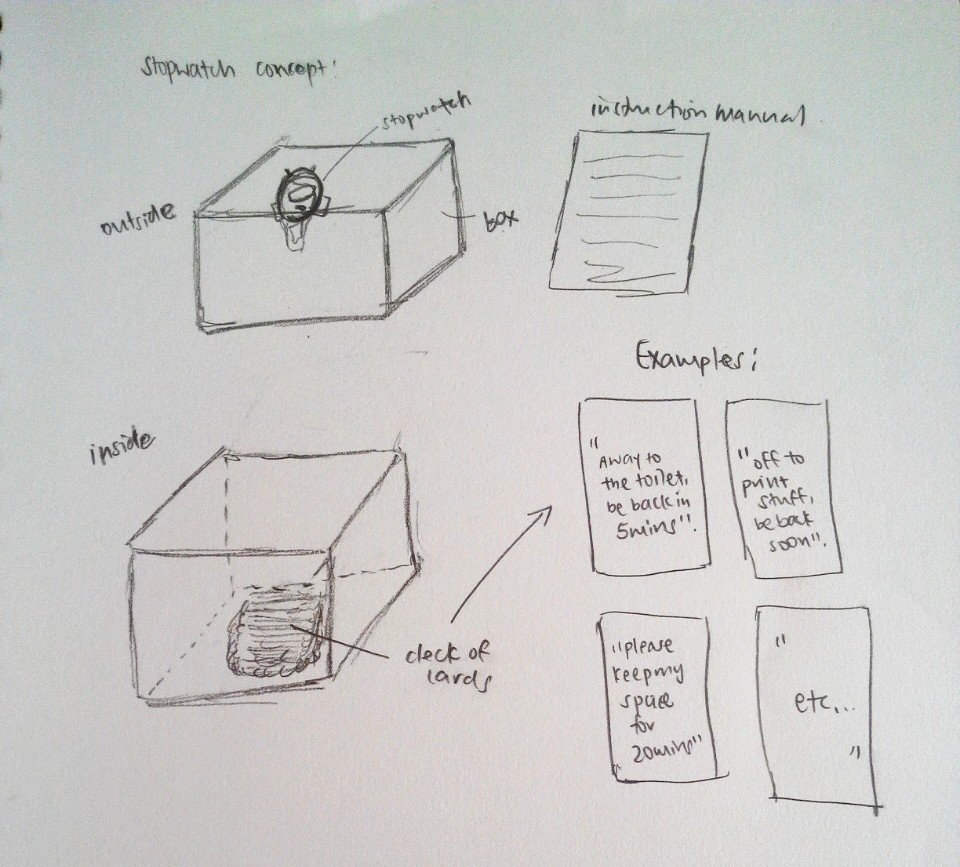What We Sea In You? Installation Process
(Group: Rochele and Ling Ern)
After our first consultation with Michael, we realised that there were quite a few technical difficulties with our decided proposal “I Chope Like That!”

Firstly, it was difficult to ensure that the mechanism of the Chope Card box will work properly. The original idea was to place the chop cards within the box with a pop open lid mechanism using a stopwatch. When the user activates the stop watch, he or she will be able to retrieve the cards from within the box. However, it was not easy to develop the mechanism. Also, there is a maximum cap on the number of laps a stop watch can take, meaning this will be a limitation on the number of users per box. In this case, for it to work, ideally, each seat should have a box in front of them. However, this will be rather cost heavy and hence not an ideal installation. Due to time management and lack of sufficient knowledge to solve the technical difficulties, we came up with another idea.
Final Proposal:

Inspired from the cloud installation from my research installation list for this library project, we decided to do something that promotes an exchange of art. Besides, from our survey in the library earlier on for this project, we realised that quite a number of people find that the library is too quiet for comfort and that it becomes somehow uninviting since the people around are all strangers but they do feel awkward if they make the first move to communicate. This leads to the fact that the interaction between the library goers are really quite low. Through this installation, we hope to create a livelier environment whereby library goers are about to immerse themselves in the installation which simulates nature, in this case, the sea, as well as have an indirect interaction with the people around them. This interaction in enabled via an exchange of art movement (one to one exchange) as mentioned earlier where library goers can take a piece of someone else’s art card off the board with every piece of art card they create and place on the board.
Initially, we wanted to create a vertical hanging area on the panels (somewhat like a laundry line) at this area:

We were thinking of coiling some thicker twine around the panels and provide some mini pegs for them to hang their cards on the strings. We also felt like attaching some fairy lights on the strings (since there is a socket nearby) to enhance the visibility of our installation.

However after much thought, we realised that putting up this way is a little cliche. People may feel an aversion towards this method as their artwork will be openly displayed in public. For those who are not confident of their artwork, they probably will not contribute or participate since it involves “baring” their work so openly. Hence we changed our location and chose the brown table instead.
Getting inspired by this

we decided to make a similar platform for the library goers to slot their cards into the silts made. This led on to the production process of our installation.
MAKING IN PROGRESS:
(I did more of the physical production while Rochele did more on the digital production)
1) Marking out the shape of the form we wanted. In this case, we feel that the shape M gives us a more even and spreaded area for the silts.

2) Me cutting the foam!

3) Notice the awkwardly vertical chunk of foam at the side with the grey duct tape? We were facing technical difficulties through our cutting process as the upper metal bar was not fully secured and it was slightly tilted downwards, resulting in our foam cutting into odd shapes. Hence, we used another piece of foam to push the bar upwards to make life easier for us.

4) It was not easy to maneuver around the thin wire cutter with this big block of foam and we kind of lost count how many times the wire broke and failed us. Perhaps the foam was too thick?

5) I then carried on to cut the foam stamps into interesting shapes.






6) We collated a small pile of usable foam stamps I cut.

7) We tried making the slits from the foam cutter and realised that it was not very easy to do so. Perhaps, a penknife will be more suitable for the job instead.

8) I created a mock up with silts to see if it works.


9) With our foams cut, we then proceeded to do up the cards. We cut out the still image and pasted them on each of the coloured blank cards. (x 100 cards)

10) Subsequently, I wanted to make a foam box with a cavity in the middle to contain the markers for the installation. I intentionally cut the waves like edges to simulate the waves at the beach. However, the cavity was not properly done and we both figured that getting a box for the stamps and markers will be neater this way.


PROCEED ON TO LOOK AT THE FINAL INSTALLATION: https://oss.adm.ntu.edu.sg/liml0074/4dii-library-installation-final-what-we-sea-in-you/






























